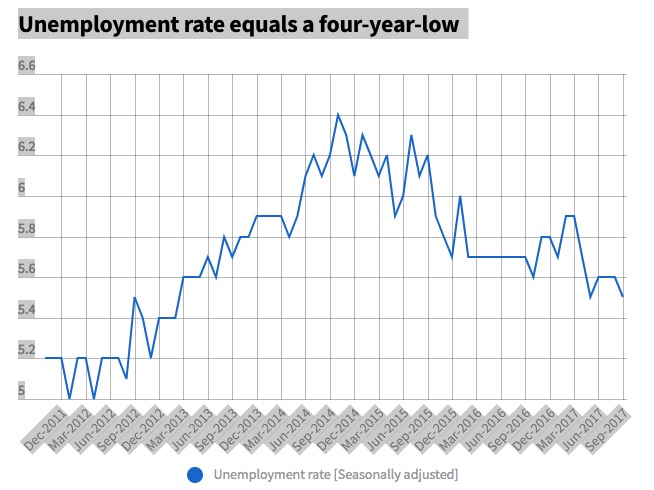Australia’s unemployment rate has hit a four-year low after falling to 5.5 per cent in September, beating market expectations.
The rate, which has not been bettered on trend or seasonally adjusted terms since February 2013, comes on the back of 19,800 jobs added in September, topping market predictions of a 15,000 rise and stirring hopes sluggish wage growth may soon turn a corner.
The 5.47 per cent seasonally adjusted result beat the 5.53 per cent figure achieved in May, according to a release by the Australian Bureau of Statistics on Thursday.
The trend employment-to-population ratio, a measure of how employed the population aged 15 years and over is, increased to 61.6 per cent, the highest it has been since August 2012.
Among the states, NSW and Victoria led the gains, adding 21,100 and 8900 jobs respectively.
The numbers have now become so positive in NSW that economists are starting to call full employment, with a jobless rate of 4.6 per cent.
Nationally, they believe wages could jump above inflation for the first time in months.
TD Securities is predicting 2.5 per cent wages growth in the next quarter, after being stuck equal to, or below, the cost of living at 1.9 per cent.

Among the states, NSW and Victoria led the gains, adding 21,100 and 8900 persons respectively on seasonally adjusted terms. Photo: Virginia Star
“The trend unemployment rate had been hovering in the range of 5.6 to 5.8 per cent for almost two years, but has now dropped to a four-year low of 5.5 per cent,” ABS chief economist Bruce Hockman said.
“Full-time employment has now increased by around 271,000 persons since September 2016, and makes up the majority of the 335,000 person net increase in employment over the period.”

Employment Minister Michaelia Cash. Photo: Andrew Meares
The participation rate – the number of people employed or actively looking for a job – was steady at 65.2 per cent.
Australia Pacific Indeed economist Callam Pickering described the figures as “an excellent set of numbers”.
Labor’s employment spokesman Brendan O’Connor. Photo: Jay Cronan“Employment up by 23,000 people in September on a trend basis, up over 335,500 over the past year,” he said.
CommSec economist Craig James said the good news kept flowing.
“More people are looking for work, more people are finding work, the lowest jobless rate for over four years,” he said.
“And at the same time, the share of women participating in the job market is the highest on record.”
He said unemployment was under 5 per cent in three of the nation’s states and territories.
“In fact, the NSW job market could be considered at full employment now with a jobless rate of 4.6 per cent.”

Employment Minister Michaelia Cash said she was acutely aware that more than 700,000 Australians remain unemployed.
“While ABS labour force figures can jump around from month to month, this is the 12th consecutive month where there has been an increase in jobs,” she said.
Labor’s employment spokesman Brendan O’Connor pointed to a report from Anglicare that coincided with Thursday’s figures
It found young job seekers were struggling, with up to five competing for each entry-level role.
“There are not enough entry-level positions for the people who want and need them, with 124,000 entry-level job seekers, but only 26,000 entry-level jobs,” he said.
The Australian dollar ticked up by a fifth of a US cent after the data’s release to be fetching US78.65 cents at 1138 AEDT before easing slightly to US78.52 cents in mid-afternoon trade.
TD Securities economist Annette Beacher said the next interest rate rise from the Reserve Bank was still not likely to be until May 2018, unless wages and inflation suddenly kicked sharply into gear.

No comments:
Post a Comment